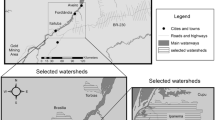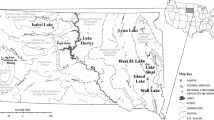Abstract
Lake Victoria, the world's largest tropical freshwater lake, is an important resource, ecologically and economically. THg distribution in the northern parts of the lake are not well known, so to answer this gap, patterns in total mercury (THg) in water, soil and two dated sediment cores from northern Lake Victoria were determined. Water THg concentrations ranged from 0.7 to 5.8 ng/L, and there were no apparent differences observed between Napoleon and Winam Gulfs. Two precipitation samples had Hg concentrations of 7 and 31 ng/L. Surface soil samples collected from various agricultural sites around Jinja, Napoleon Gulf, have THg concentrations between 12.7 and 48.4 ng/g dry weight; they were correlated with organic carbon, total phosphorus and % clay. A near-shore core taken in Itome Bay in Napoleon Gulf, and an offshore core collected from the deepest part of the lake had similar THg concentrations and profiles (78 to 458 ng/g dry weight). The increase in THg concentration in the profiles of both cores began around 1960 and peaked around 1980. The similar sedimentary THg profiles and fluxes in the cores suggest that the THg sources to L. Victoria are primarily atmospheric, with some erosion inputs, and that equatorial African ecosystems are not exempt from the global increase in baseline THg concentrations.
Similar content being viewed by others
References
Amyot M., Lean D.R.S., Poissant L. and Doyon M.-R. 2000. Distribution and transformation of elemental mercury in the St. Lawrence River and Lake Ontario. Can. J. Fish. Aquat. Sci. 51,(Suppl. 1): 155–163.
Baker P.G.L., Brunke E.-G., Slemr F. and Crouch A.M. 2002. Atmospheric mercury measurements at Cape Point, South Africa. Atmos. Environ. 36: 2459–2465.
Bloom N.S. and Fitzgerald W. 1988. Determination of volatile mercury species at the picogram level by low temperature gas chromatography with cold-vapour atomic fluorescence detection. Anal. Chim. Acta. 208: 151–161.
Bowles K.C., Apte S.C., Maher W.A., Kawei M. and Smith R. 2001. Bioaccumulation and biomagnification of mercury in Lake Murray, Papua New Guinea. Can. J. Fish. Aquat. Sci. 58: 888–897.
Brunke E.G., Labuschagne C. and Slemr F. 2001. Gaseous mercury emissions from a fire in the Cape Penisula, South Africa during January 2000. Geophys. Res. Lett. 28: 1483–1486.
Campbell L.M., Hecky R.E. and Dixon D.G. Review of mercury in Lake Victoria (East Africa): Implications for human and ecosystem health. Journal of Toxicology and Environmental Health, Part B, In press-a (in press).
Campbell L.M., Hecky R.E., Nyaundi J., Muggide R. and Dixon D.G. Distribution and food-web transfer of mercury in Napoleon and Winam Gulfs, Lake Victoria, East Africa. J. Great Lakes Res., In press-b (in press).
DeMaster D.J. 1981. The supply and accumulation of silica in the marine environment. Geochim. Cosmochim. Acta. 45: 1715–1732.
Dwyer E., Pinnock S., Grégoire J.-M. and Pereira J.M.C. 2000. Global spatial and temporal distribution of vegetation fire as determined from satellite observations. Int. J. Remote Sensing 21: 1289–1302.
Fitzgerald W.F., Engstrom D.R., Mason R.P. and Nater E.A. 1998. The case for atmospheric mercury contamination in remote areas. Environ. Sci. Technol. 32: 1–7.
Fostier A.-H., Forti M.C., Guimarães J.R.D., Melfi A.J., Boulet R., Espirito Santo C.M. et al. 2000. Mercury fluxes in a natural forested Amazonian catchment (Serra do Navio, Amapá State, Brazil). Sci. Tot. Environ. 260: 201–211.
Freidli H.R., Radke L.F. and Lu J.Y. 2001. Mercury in smoke from biomass fires. Geophysical Research Lett. 28: 3223–3226.
Gilmour C.G., Riedel G.S., Ederington M.C., Bell J.T., Benoit J.M., Gill G.A. et al. 1998. Methylmercury concentrations and production rates across a trophic gradient in the northern Everglades. Biogeochemistry 40: 327–345.
Glass G.E. and Sorensen J.A. 1999. Six-year trend (1990–1995) of wet mercury deposition in the upper midwest, USA. Environ. Sci. Technol. 33: 3303–3312.
Hecky R.E. 1993. The eutrophication of Lake Victoria. Verh. Internat. Verein. Limnol. 25: 39–48.
Hecky R.E. and Bugenyi F.W.B. 1992. II. Water Quality: Hydrology and chemistry of the African Great Lakes and water quality issues: Problems and solutions. Mitt. Internat. Verein. Limnol. 23: 45–54.
Ikingura J.R. and Akagi H. 1996. Monitoring of fish and human exposure to mercury due to gold mining in the Lake Victoria goldfields, Tanzania. Sci. Tot. Environ. 191: 59–68.
Karim M.I. and Adams W.A. 1984. Relationships between sequioxides, kaolinite and phosphate sorption in a catena of oxisols in Malawi. Soil Sci. Soc. Am. J. 48: 406–409.
Lamborg C.H., Rolfhus K.R., Fitzgerald W.F. and Kim G. 1999. The atmospheric cycling and air-sea exchange of mercury species in south and equatorial Atlantic Ocean. Deep-Sea Research Part II – Topical Studies in Oceanograph 46: 957–977.
Landers D.H., Gubala C., Verta M., Lucotte M., Johansson K., Vlasova T. et al. 1998. Using lake sediment mercury flux ratios to evaluate the regional and continental dimensions of mercury deposition in Arctic and boreal ecoystems. Atmos. Environ. 32: 9119–9928.
Lindenschmidt K.-E., Suhr M., Magumba M.K., Hecky R.E. and Bugenyi F.W.B. 1998. Loading of solute and suspended solids from rural catchment areas flowing into Lake Victoria in Uganda. Wat. Res. 32: 2776–2786.
Lipiatou E., Hecky R.E., Eisenreich S.J., Lockhart L., Muir D. and Wilkinson P. 1996. Recent ecosystem changes in Lake Victoria reflected in sedimentary natural and anthropogenic organic compounds. In: Johnson T.C. and Odada E.O. (eds), The Limnology, Climatology, and Paleoclimatology of the East African Lakes. Gordon and Breach Publishers, Amsterdam, The Netherlands, pp. 523–541.
Mason R.P. and Sullivan K.A. 1997. Mercury in Lake Michigan. Environ. Sci. Technol. 31: 942–947.
Meili M. 1997. Mercury in Lakes and Rivers. Metal Ions in Biological Systems 34: 21–51.
Meuleman C., Leermakers M. and Baeyens W. 1995. Mercury speciation in Lake Baikal. Water Air Soil Pollut. 80: 539–551.
Mudroch A., Sarazin L. and Lomas T. 1988. Summary of surface and background concentrations of selected elements in the Great Lakes sediments. J. Great Lakes Res. 14: 241–251.
Ollier C.D. and Harrop J.F. 1959. The Soils of the Eastern Province of Uganda: Memoirs of the Research Division, Series 1. Department of Agriculture, Uganda Protectorate (currently available from the Kawanda Agriculture Research Institute, National Agricultural Research Organization, Kawanda, Uganda), Kawanda, Uganda, No. 2. pp.
Ontario Ministry of Environment 1999. Automated Determination of Total Mercury at Ultratrace Levels in Environmental Samples. Laboratory Services Branch, Ontario Ministry of Environment, Toronto.
Pitcher T.J. and Hart P.J.B. (eds) 1995. The Impact of Species Changes in African Lakes. Chapman & Hall, London, Great Britain, 601 pp.
Poissant L. and Pilote M. 1998. Mercury concentrations in single event precipitation in southern Québec. Sci. Tot. Environ. 213: 65–72.
Ramlal P.S., Bugenyi F.W.B., Kling G.W., Nriagu J.O., Rudd J.W.M. and Campbell L.M. Lake Victoria, East Africa: Mercury concentrations in water, sediment, and biota. J. Great Lakes Res., In press (in press).
Reedman J.H. 1984. Resources of phosphate, niobium, iron, and other elements in residual soils over the Sukulu Carbonatite Complex, southeastern Uganda. Economic Geology 79: 716–724.
Robbins J.A. and Kemp A.L.W. 1978. Comparative 210Pb, 137Cs, and pollen geochronologies of sediments from lakes Ontario and Erie. Quaternary Res. 10: 256–278.
Roulet M., Lucotte M., Canuel R., Rheault I., Tran S., De Freitos Gog Y.G. et al. 1998a. Distribution and partition of total mercury in waters of the Tapajós River Basin, Brazilian Amazon. Sci. Tot. Environ. 213: 203–211.
Roulet M., Lucotte M., Saint-Aubin A., Tran S., Rhéault I., Farella N. et al. 1998b. The geochemistry of mercury in central Amazonian soils developed on the Alter-do-Chão formation of the lower Tapajós River Valley, Pará state, Brazil. Sci. Tot. Environ. 223: 1–24.
Scholes M. and Andreae M.O. 2000. Biogenic and pyrogenic emissions from Africa and their impact on the global atmosphere. Ambio. 29: 23–29.
SPSS Inc. 1998. SYSTAT Version 10. Computer Statistical Software.
Stainton M.P., Capel M.J. and Armstrong F. 1977. The Chemical Analysis of Fresh Water. Freshwater Institute, Canadian Fisheries and Marine Service Spec. Publication, Winnipeg, MB, Canada.
The Republic of Uganda 1999. State of the Environment Report for Uganda 1998. ISBN 9970 410 014. National Environmental Management Authority, Kampala, Uganda.
Turner L.J. 1990. CCIW Laboratory Manual for the Determination of Metals, Total Iron, Phosphorus, Carbon, Sulfur and Mossbauer Analyses of Sediment and Suspended Sediument Samples. Canada Centre for Inland Waters, Burlington, Ontario, Canada.
U.S.E.P.A. 1999. Method 1631, Revision B. Mercury in Water by Oxidation, Purge and Trap, and Col Vapor Atomic Fluorescence Spectrometry. United States Environmental Protection Agency, Office of Water 4303. Report No. EPA-821-R-99-005., Also found at http://www.epa.gov/ost/methods/ 1631method.html.
van Straaten P. 2000. Mercury contamination associated with small scale gold mining in Tanzania and Zimbabwe. Sci. Tot. Environ. 259: 105–113.
Verschuren D., Edgington D.N., Kling H.J. and Johnson T.C. 1998. Silica depletion in Lake Victoria: sedimentary signals at offshore stations. J. Great Lakes Res. 24: 118–130.
Verschuren D., Johnson T.C., Kling H.J., Edgington D.N., Leavitt P.R., Brown E.T. et al. 2002. History and timing of human impact on Lake Victoria, East Africa. Proceedings B of The Royal Society of London 269: 289–294.
Yin X. and Nicholson S.E. 2000. On the diurnal cycle of cloudiness over Lake Victoria and its influence on evaporation from the lake. Hydrol. Sci. 45: 407–424.
Zar J.H. 1984. Biostatistical Analysis. Simon & Schuster Co., Eaglewoods Cliffs, New Jersey, USA, 718 pp.
Rights and permissions
About this article
Cite this article
Campbell, L., Hecky, R., Muggide, R. et al. Variation and distribution of total mercury in water, sediment and soil from northern Lake Victoria, East Africa. Biogeochemistry 65, 195–211 (2003). https://doi.org/10.1023/A:1026058417584
Issue Date:
DOI: https://doi.org/10.1023/A:1026058417584




